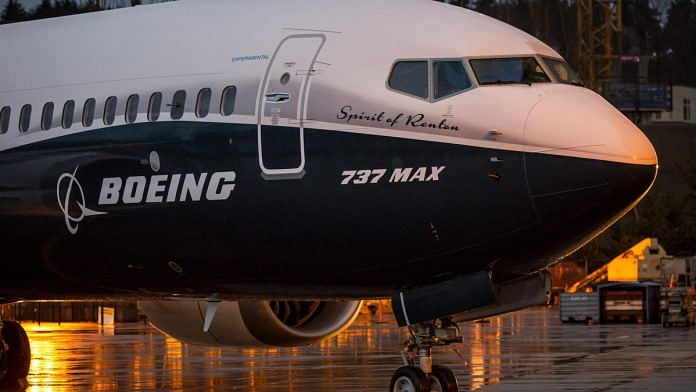Washington/Nairobi: Pilots on a doomed Ethiopian Airlines flight followed proper procedures and still couldn’t bring the 737 Max out of a dive, Ethiopia’s transport minister said, pressing manufacturer Boeing Co. to fix flight controls to avoid further disasters.
Boeing needs to review the flight-control system to ensure the plane’s safety, Ethiopian Transport Minister Dagmawit Moges said at a news conference in the capital of Addis Ababa on Thursday after completing a preliminary report. Aviation authorities should verify the issues have been adequately addressed “before the release of the aircraft to operations.”
The report adds to pressure on Boeing to prove its best-selling 737 Max jet is safe after Ethiopian Airlines Flight 302 smashed into the ground about six minutes after takeoff on March 10. The disaster was the second involving a 737 Max in five months. A Lion Air plane plunged into the Java Sea in October and killed 189 people after an automatic system that can push the plane’s nose down was activated, and the model is now grounded worldwide as investigators probe its airworthiness and how it gained permission to fly.
The so-called MCAS system was active during the Ethiopian flight, Dagmawit told the New York Times after the news conference.
The report is “significantly bad news for Boeing,” Michael Hewson, chief market analyst at CMC Markets UK said by phone. “They’re saying that the pilots were not to blame. It places much more scrutiny on Boeing’s processes.”
Pilot Training
One question raised by the Ethiopian report is whether guidance issued to pilots by Boeing in the wake of the Lion Air crash was sufficient. While the US manufacturer and aviation regulators made a point of telling airlines worldwide how to disarm MCAS, the pilots of the Ethiopian Airlines plane were found to have followed “all the procedures repeatedly,” according to Dagmawit.
The investigation, staffed by Ethiopian, US and European safety experts, has pitted Boeing’s reputation for technical quality against a successful, modern African airline that’s a symbol of pride for Ethiopia. Importantly, Dagmawit said there were no dissenting voices among participants who worked on the preliminary report, which was sent to the 34 nations with citizens aboard the flight. The full report is expected to be completed within one year.
“Despite full compliance with the emergency procedures,” pilots could not recover from the “persistence of nose diving,” state-owned Ethiopian Airlines said. The crew followed recommendations mapped out by Boeing and approved by the US Federal Aviation Administration, the airline said.
Boeing said it’s reviewing the findings and the FAA said it’s working to understand what happened. Boeing shares were little changed before the start of regular trading in New York.
MCAS Focus
The details underscore the focus on the Maneuvering Characteristics Augmentation System, a new anti-stall software feature installed on the fourth generation of the 737, the world’s best-selling commercial aircraft family.
“It is recommended that the aircraft flight control system related to the flight controllability shall be reviewed by the manufacturer,” Dagmawit said at the news conference, without directly naming the MCAS.
The crash has also raised questions about the aircraft’s approval to fly. In the US, the Transportation Department has ordered a full audit of the FAA’s 2017 certification of the Max and the Justice Department is also investigating.
China said it’s been invited by the FAA to join a panel to review the 737 Max. China was one of the first countries to ground the American narrow-body jet.
Boeing has spent months refining the 737 Max’s software since data from the Lion Air crash indicated the stall-avoidance system had repeatedly tipped the nose down before pilots lost control. Boeing was close to a software fix when the Ethiopian Airlines jet went down.
Planes usually climb steadily to get safely away from terrain and to reach altitudes where engines burn more efficiently.
“Pilots tried to control the plane repeatedly but were not able to do so,’’ Dagmawit said at the briefing. The plane appeared “very normal” on takeoff and then suffered “repetitive uncommanded nose-down.”
Captain Yared Getachew, in command of the Ethiopian Airlines flight, had amassed more than 8,000 flight hours, according to the airline, while first officer Ahmed Nur Mohammod had spent about 200 hours aloft.
Passengers included 32 Kenyans, 18 Canadians, nine Ethiopians and eight Americans. The United Nations, which was hosting an environmental conference in Nairobi, said it lost 19 staff members in the crash.
While Africa has a generally poor aviation safety record compared with global norms, Ethiopian Airlines is known for operating a modern fleet that features Boeing 787 Dreamliners and the latest Airbus SE A350, as well as the 737 Max.
Africa’s only consistently profitable carrier, Ethiopian has built Addis Ababa into a major hub feeding travelers from around the world into dozens of African cities in competition with rivals such as Dubai-based Emirates.
Boeing designed the 737 Max to deliver a 14 per cent fuel-savings to compete with the A320neo from the company’s European rival, Airbus. The use of new, bigger engines required Boeing’s designers to mount the units farther forward on the wings in order to give them proper ground clearance when taking off or landing. That changed the flying characteristics in a way that the engineers thought required the additional system to prevent stalls.
Ethiopian safety officials stopped short of saying the plane needs a redesign.
“Is there a structural design problem? No, we cannot characterize it now,” said Amdye Andualem, the investigator in charge, told the news conference. The investigation found no evidence that a foreign object may have struck the plane, he said, adding that the probe would continue for six months or more.
Also read: Boeing will find it harder to explain itself in the Lion Air and Ethiopian Airlines plane crashes






